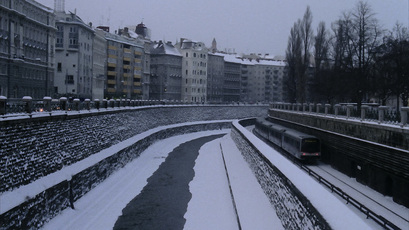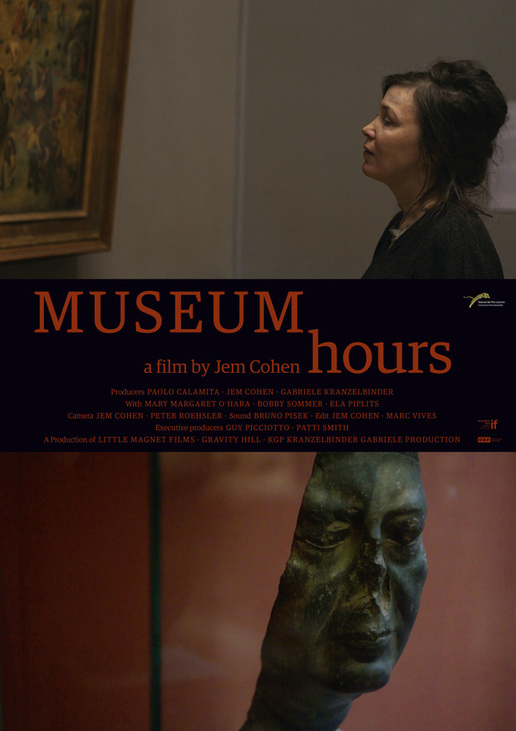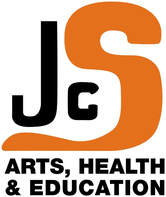
CAST & CREW
Featuring Bobby Sommer
Ela Piplits
Mary Margaret O’Hara
Written and Directed by Jem Cohen
In English and German, with English subtitles
Running time: 107 minutes
This film is Not Rated
Featuring Bobby Sommer
Ela Piplits
Mary Margaret O’Hara
Written and Directed by Jem Cohen
In English and German, with English subtitles
Running time: 107 minutes
This film is Not Rated
Reviewed by A. O. Scott – NY Times
The distinction between life and art is one that all genuine works of art live to unmake, even if the circumstances in which
we experience art have a way of maintaining the barrier. An art museum, for example, is designated as a place apart from the zones of ordinary existence. We enter to gaze upon beautiful artifacts at a safe distance, standing at the boundary between tedium and rapture. But really, and fortunately, a museum is no different from anywhere else, since beauty and meaning are everywhere, provided we know how to look.
“Museum Hours,” Jem Cohen’s quietly amazing, sneakily sublime new film, is partly a reflection on such aesthetic puzzles. Shot on high-definition digital video and super-16-millimeter film in the Kunsthistorisches Museum in Vienna, the film lingers over great paintings by Rembrandt, Bruegel and other European masters, inviting us to contemplate the complex, half-obscured tales they might tell. In one scene, an art historian (Ela Piplits) tries to initiate a crowd of skeptical tourists into the mysteries of Bruegel’s “Conversion of St. Paul” (1567), and Mr. Cohen’s camera supports her arguments by finding details in the picture that might be easy to overlook.
The museum is also the setting for a contemporary story of cross-cultural friendship. Johann (Bobby Sommer), an Austrian man in his 60s who once worked as a road manager for hard-rock bands, now makes his living as a security guard at the museum. A tolerant, philosophical fellow, he muses (in voice-over narration) on both the artworks and the tourists and schoolchildren who shuffle past them, finding the spectacle of spectatorship endlessly interesting.
In the course of his duties, Johann meets Anne (Mary Margaret O’Hara), a Canadian woman who has come to Vienna to sit at the bedside of a cousin who is in a coma at a local hospital. Johann serves as Anne’s interpreter and advocate in her dealings with the medical authorities, and also becomes her impromptu tour guide. Together they visit some of Vienna’s famous sites and also some of its workaday cafes and bars. They drink beer, talk about their lives and develop a connection that, while apparently not sexual (Johann is gay), is nonetheless deeply romantic.
Mr. Cohen, a New York filmmaker and video artist with an eye for rough urban landscapes and eccentric artistic characters, is a patient observer and a cunning, subtle storyteller. “Museum Hours” seems to wander and ruminate, collecting stray moments and fleeting impressions that gradually — and perhaps only in retrospect — snap together to reveal an intriguing pattern of emotion and significance. Watching the film is not really like looking at a painting, but the way the art historian looks at Bruegel has something in common with the way Mr. Cohen instructs us to pay attention to the world.
Though “Museum Hours” glances at medieval and classical works, its gallery-strolling focus is on those Dutch and Flemish paintings from the early modern period that turned ordinary faces and everyday events into subjects for exalted artistic scrutiny. The movie, by visual example rather than thematic argument, shows that this impulse is still very much alive. A modern city or a middle-aged face can be regarded with Rembrandt-like sympathy or Bruegelesque curiosity, through a camera or a pair of eyes. This movie is rigorously and intensely lifelike, which is to say that it’s also a strange and moving work of art.
The distinction between life and art is one that all genuine works of art live to unmake, even if the circumstances in which
we experience art have a way of maintaining the barrier. An art museum, for example, is designated as a place apart from the zones of ordinary existence. We enter to gaze upon beautiful artifacts at a safe distance, standing at the boundary between tedium and rapture. But really, and fortunately, a museum is no different from anywhere else, since beauty and meaning are everywhere, provided we know how to look.
“Museum Hours,” Jem Cohen’s quietly amazing, sneakily sublime new film, is partly a reflection on such aesthetic puzzles. Shot on high-definition digital video and super-16-millimeter film in the Kunsthistorisches Museum in Vienna, the film lingers over great paintings by Rembrandt, Bruegel and other European masters, inviting us to contemplate the complex, half-obscured tales they might tell. In one scene, an art historian (Ela Piplits) tries to initiate a crowd of skeptical tourists into the mysteries of Bruegel’s “Conversion of St. Paul” (1567), and Mr. Cohen’s camera supports her arguments by finding details in the picture that might be easy to overlook.
The museum is also the setting for a contemporary story of cross-cultural friendship. Johann (Bobby Sommer), an Austrian man in his 60s who once worked as a road manager for hard-rock bands, now makes his living as a security guard at the museum. A tolerant, philosophical fellow, he muses (in voice-over narration) on both the artworks and the tourists and schoolchildren who shuffle past them, finding the spectacle of spectatorship endlessly interesting.
In the course of his duties, Johann meets Anne (Mary Margaret O’Hara), a Canadian woman who has come to Vienna to sit at the bedside of a cousin who is in a coma at a local hospital. Johann serves as Anne’s interpreter and advocate in her dealings with the medical authorities, and also becomes her impromptu tour guide. Together they visit some of Vienna’s famous sites and also some of its workaday cafes and bars. They drink beer, talk about their lives and develop a connection that, while apparently not sexual (Johann is gay), is nonetheless deeply romantic.
Mr. Cohen, a New York filmmaker and video artist with an eye for rough urban landscapes and eccentric artistic characters, is a patient observer and a cunning, subtle storyteller. “Museum Hours” seems to wander and ruminate, collecting stray moments and fleeting impressions that gradually — and perhaps only in retrospect — snap together to reveal an intriguing pattern of emotion and significance. Watching the film is not really like looking at a painting, but the way the art historian looks at Bruegel has something in common with the way Mr. Cohen instructs us to pay attention to the world.
Though “Museum Hours” glances at medieval and classical works, its gallery-strolling focus is on those Dutch and Flemish paintings from the early modern period that turned ordinary faces and everyday events into subjects for exalted artistic scrutiny. The movie, by visual example rather than thematic argument, shows that this impulse is still very much alive. A modern city or a middle-aged face can be regarded with Rembrandt-like sympathy or Bruegelesque curiosity, through a camera or a pair of eyes. This movie is rigorously and intensely lifelike, which is to say that it’s also a strange and moving work of art.






